Toyota Avensis 2003, Avensis 2004, Avensis 2005 User Manual
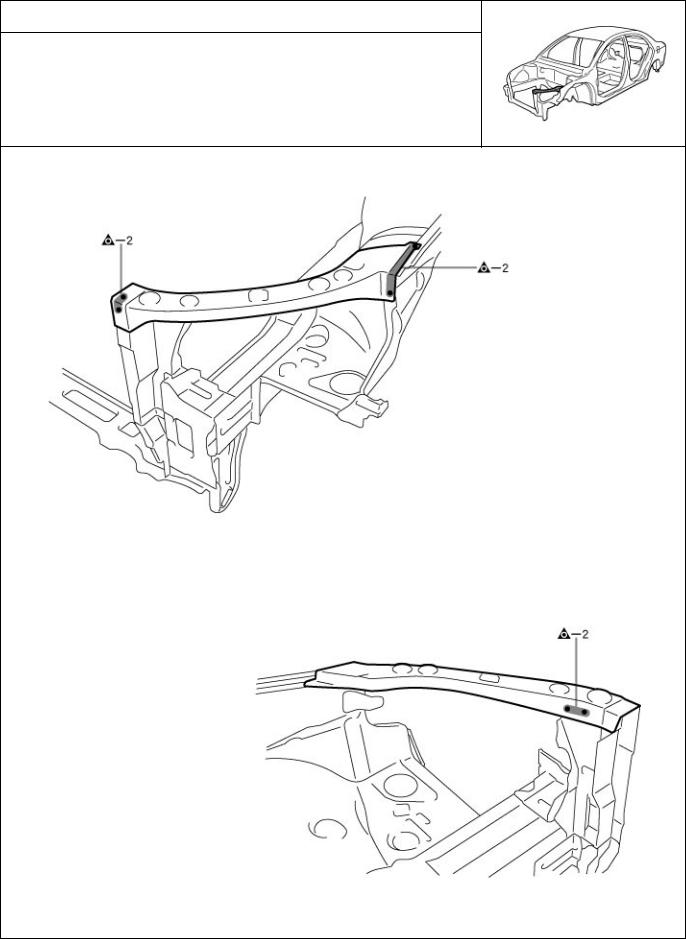
BODY PANEL REPLACEMENT |
BP-1 |
RADIATOR UPPER SUPPORT (ASSY)
REMOVAL
F14459-A
F14459
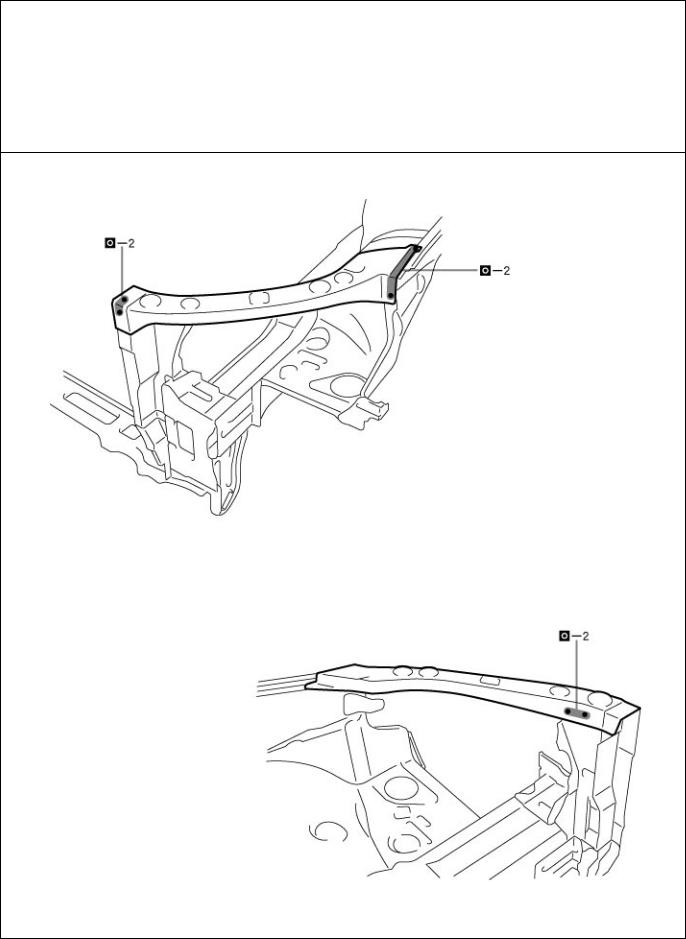
BP-2 |
BODY PANEL REPLACEMENT |
INSTALLATION
STemporarily install the new parts and measure each part of the new parts in accordance with the body dimension diagram. (See the body dimension diagram)
SInspect the fitting of the related parts around the new parts before welding. This affects the appearance of the finish.
SAfter welding, apply the polyurethane foam to the corresponding parts.
SAfter welding, apply body sealer and under-coating to the corresponding parts.
SAfter applying the top coat layer, apply anti-rust agent to the inside of the necked section structural weld spots.
F14460
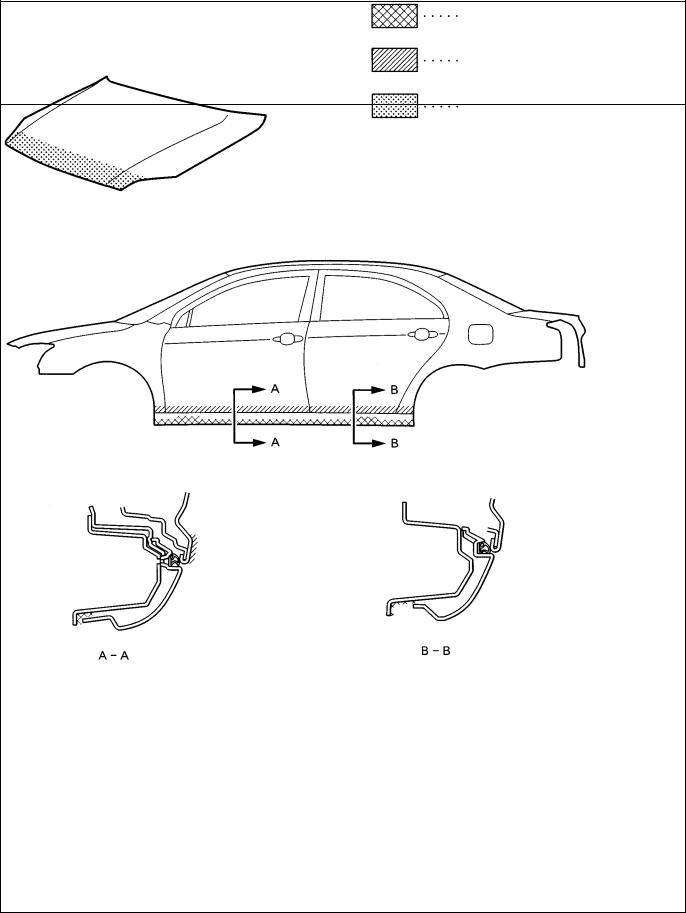
PAINT S COATING |
PC-19 |
BODY PANEL ANTI-CHIPPING PAINT APPLICATION AREAS
HINT:
1)Anti-chipping paint should be applide to some areas before the second coat and to others after the top coat.
2)If other areas are accidentally coated, wipe of the paint immediately with a rag soaked in grease, wax and silicone remover.
PVC Chipping Primer
Urethane Primer
Soft - Chip Primer (Poly Olefine)
F14419
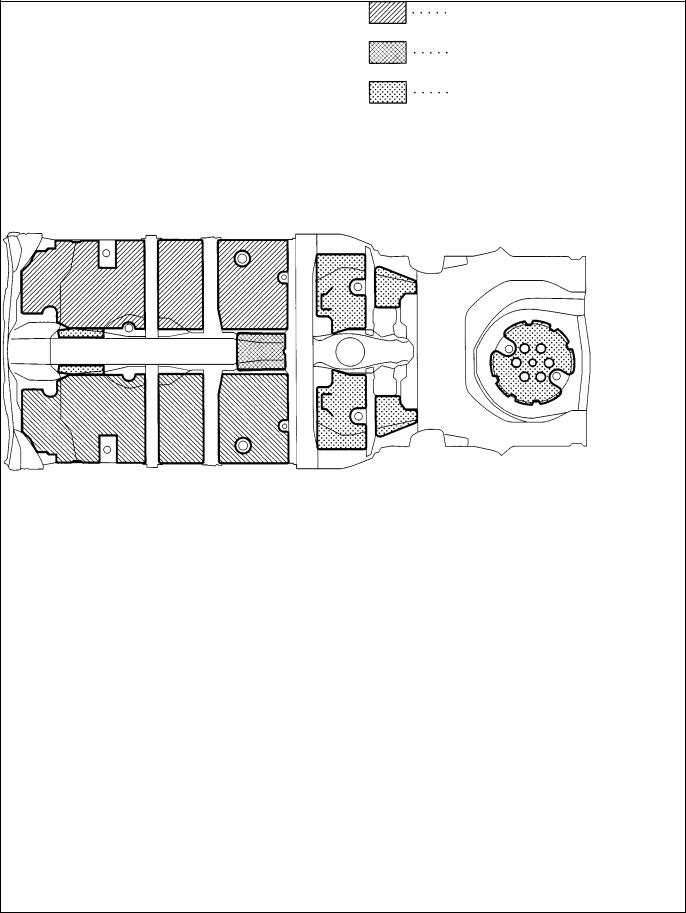
PC-18 |
PAINT S COATING |
SILENCER SHEET INSTALLATION AREAS
Thickness of Asphalt Sheet
1.6mm (0.063in.)
1.8mm (0.071in.)
3.0mm (0.118in.)
F14418
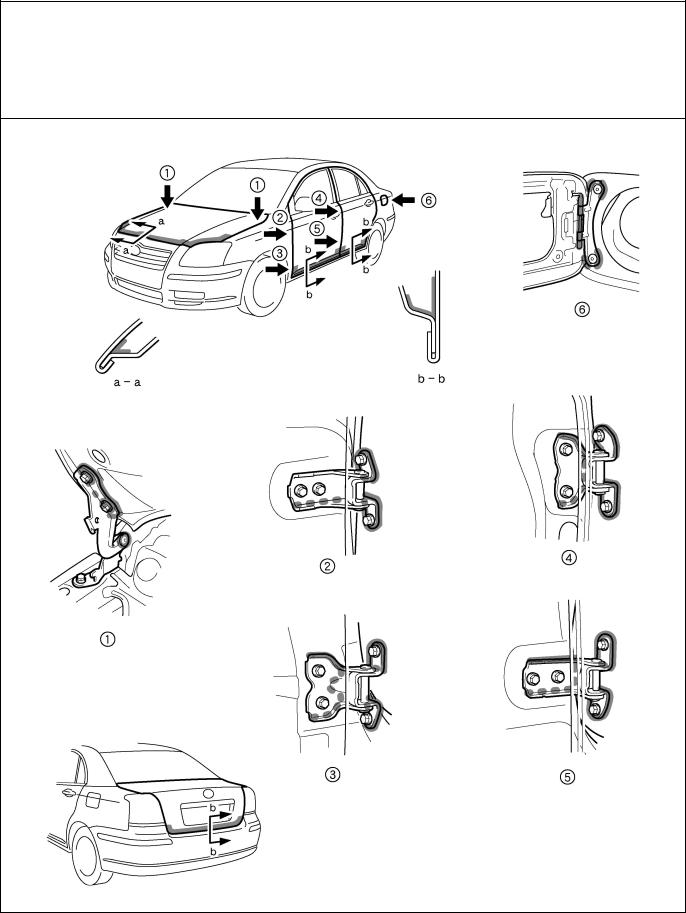
PAINT S COATING |
PC-15 |
BODY PANEL ANTI-RUST AGENT (WAX) APPLICATION AREAS
HINT:
1)Whenever adjusting the doors and hoods, apply anti-rust agent (wax) around the hinges.
2)Even if partially repairing a part, apply anti-rust agent (wax) over the entire application area of the part.
3)Wipe off the anti-rust agent immediately with a rag soaked in a grease, wax and silicone remover, if accidently applied to other areas.
[Sedan]
F14412
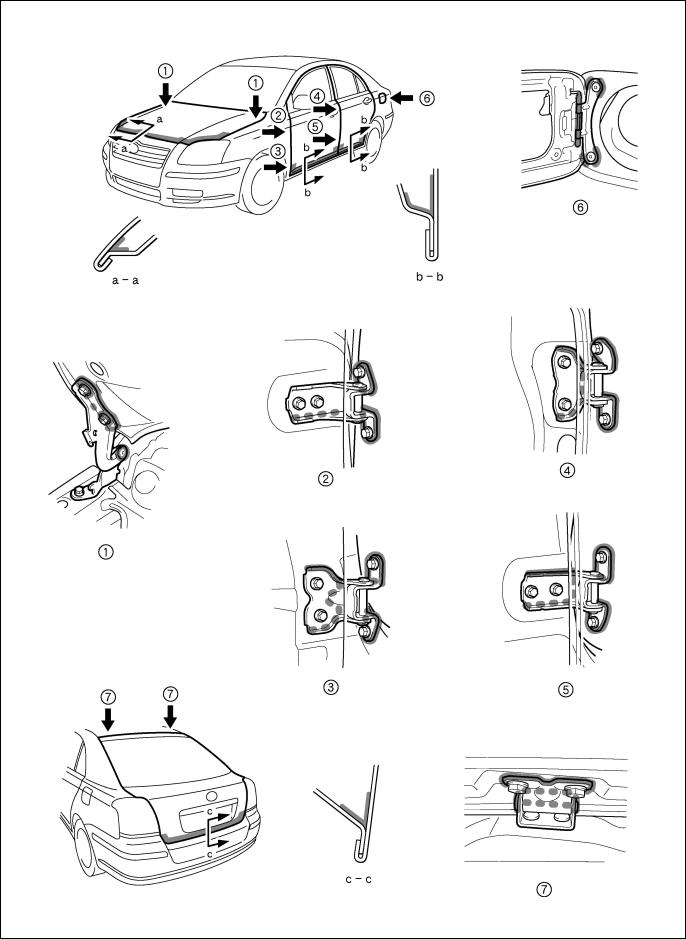
PC-16 |
PAINT S COATING |
[Liftback]
F14414

PAINT S COATING |
PC-17 |
[Wagon]
F14413

PC-12 |
PAINT S COATING |
FOAMED MATERIAL APPLICATION AREAS
The sections shown in the figure below are filled with foamed material to provide noise insullation. After repairing these sections or their peripheries, refill with foamed materials
HINT:
1)Use the service holes located on the reverse side of the body panel to refill with foamed materials.
2)When handling foamed material, follow the directions of the material’s manufacturer.
[Sedan]
F14415

PAINT S COATING |
PC-13 |
[Liftback]
F14417

PC-14 |
PAINT S COATING |
[Wagon]
F14416

PAINT S COATING |
PC-11 |
BODY PANEL UNDERCOATING AREAS
HINT:
1)First wipe off any dirt, grease or oil with a rag soaked in a grease, wax and silicone remover.
2)Cover the surrounding areas with masking paper to avoid coating unnecessary areas. If other areas are accidently coated, wipe off the coating immediately.
3)Apply the first coating of undercoat to all welded areas and panel joints, then apply a second coat over the entire area.
4)Do not coat parts which become hot, such as the tailpipe, or moving parts, such as the propeller shaft.
5)Besides the locations described below, apply undercoating to all weld points under the body to insure corrosion prevention.
6)Be sure to seal the edge of the flange of the member and bracket with undercoating.
7)If undercoat is damaged by peeling, cracks, etc., be sure to repair as necessary.
8)Before the undercoat apply sealer allowing rust prevention to be attained.
F14411
REFERENCE
Referring to the notes above, undercoating should be applied according to the specifications for your country.
IN-18 |
INTRODUCTION |
ABBREVIATIONS USED IN THIS MANUAL
For convenience, the following abbreviations are used in this manual.
ABS
A/C assy ECT ECU e.g.
Ex.
FWD 4WD in.
LH
LHD
MIG
M/Y
PPS
RH
RHD
SRS
SSM w/ w/o
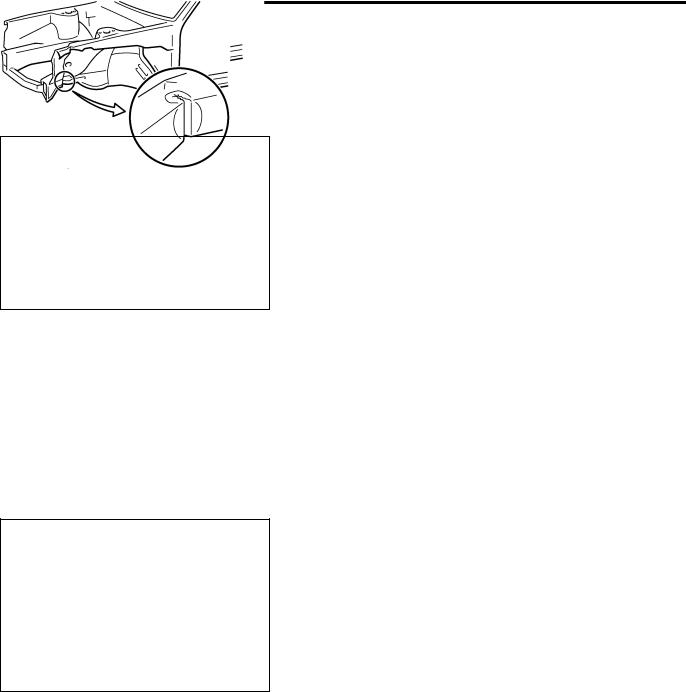
IN-16
INTRODUCTION
PRECAUTIONS FOR REPAIRING BODY STRUCTURE PANELS
1.HEAT REPAIR FOR BODY STRUCTURE PANELS
Toyota prohibits the use of the heat repair method on body structure panels when repairing a vehicle damaged in a collision.
Panels that have high strength and rigidity, as well as a long life span for the automobile body are being sought after. At Toyota, in order to fulfill these requirement, we use high tensile strength steel sheets and rust preventive steel sheets on the body.
High tensile steel sheets are made with alloy additives and a special heat treatment in order to improve the strength. To prevent the occurrence of rust for a long period of time, the surface of the steel is coated with a zinc alloy.
If a body structure parts are heat repaired with an acetylene torch or other heating source, the crystalline organization of the steel sheet will change and the strength of the steel sheet will be reduced.
The ability of the body to resist rust is significantly lowered as well since the rust resistant zinc coating is destroyed by heat and the steel sheet surface is oxidized.
2.STRUCTURE PANEL KINKS
A sharp deformation angle on the panel that cannot be returned to its original shape by pulling or hammering is called a kink.
Since structure parts were designed to exhibit a 100% performance when they were in their original shape, if they are deformed in an accident, or if the deformed parts are repaired and reused, they become unable to exhibit the same performance as intended in the design.
It is necessary to replace the part where the kink has occurred.
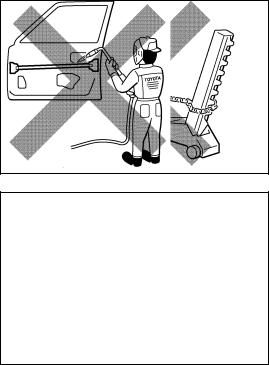
INTRODUCTION |
IN-17 |
3.IMPACT BEAM REPAIR
The impact beam and bracket are necessary and important parts in maintaining a survival space for passengers in a side collision.
For impact beam, we use special high tensile strength steel.
The high tensile strength steel maintains its special crystalline organization by heat treatment or alloy additives. Since these parts were designed to exhibit a 100% performance when they were in their original shape, if they are deformed in an accident, or if the deformed parts are repaired and reused, they become unable to exhibit the same performance as intended in the design.
It is necessary to replace the door assembly when impact beam or bracket is damaged.

INTRODUCTION |
IN-15 |
HANDLING PRECAUTIONS ON RELATED COMPONENTS
1.BRAKE SYSTEM
The brake system is one of the most important safety components. Always follow the directions and notes given in section BR of the repair manual for the relevant model when handling brake system parts.
NOTICE: When repairing the brake master cylinder or TRAC system, bleed the air out of the TRAC system.
2.DRIVE TRAIN AND CHASSIS
The drive train and chassis are components that can have great effects on the running performance and vibration resistance of the vehicle. After installing components in the sections listed in the table below, perform alignments to ensure correct mounting angles and dimensions. Particularly accurate repair of the body must also be done to ensure correct alignment.
HINT: Correct procedures and special tools are required for alignment. Always follow the directions given in the repair manual for the relevant model during alignment and section DI of this section.
Component to be aligned |
Section of repair manual |
|
for relevant model |
||
|
||
Front Wheels |
Front Suspension (26) section |
|
Rear Wheels |
Rear Suspension (27) section |
3.COMPONENTS ADJACENT TO THE BODY PANELS
Various types of component parts are mounted directly on or adjacently to the body panels. Strictly observe the following precautions to prevent damaging these components and the body panels during handling.
SBefore repairing the body panels, remove their components or apply protective covers over the components.
SBefore prying components off using a screwdriver or a scraper, etc., attach protective tape to the tool tip or blade to prevent damaging the components and the body paint.
SBefore removing components from the outer surface of the body, attach protective tape to the body to ensure no damage to painted areas.
HINT: Apply touch-up paint to any damaged paint surfaces.
SBefore drilling or cutting sections, make sure that there are no wires, etc. on the reverse side.
4.ECU (ELECTRONIC CONTROL UNIT)
Many ECUs are mounted in this vehicle.
Take the following precautions during body repair to prevent damage to the ECUs.
SBefore starting electric welding operations, disconnect the negative (–) terminal cable from the battery.
When the negative (–) terminal cable is disconnected from the battery, memory of the clock and audio systems will be cancelled. So before starting work, make a record of the contents memorized by each memory system. Then when work is finished, reset the clock and audio systems as before.
When the vehicle has tilt and telescopic steering, power seat and outside rear view mirror, which are all equipped with memory function, it is not possible to make a record of the memory contents.
So when the operation is finished, it will be necessary to explain this fact to the customer, and request the customer to adjust the features and reset the memory.
SDo not expose the ECUs to ambient temperatures above 80_C (176_F).
NOTICE: If it is possible the ambient temperature may reach 80_C (176_F) or more, remove the ECUs from the vehicle before starting work.
SBe careful not to drop the ECUs and not to apply physical shocks to them.
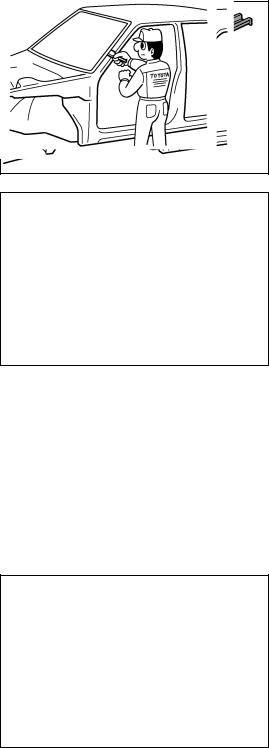
IN-10 |
INTRODUCTION |
PROPER AND EFFICIENT WORK
PROCEDURES
1.REMOVAL
(a)PRE-REMOVAL MEASURING
(1)Before removal or cutting operations, take measurements in accordance with the dimension diagram. Always use a puller to straighten a damaged body or frame.
F10007
Cutting Okay
Reinforcement
Corners
F10008A
WRONG |
F10009A |
(b)CUTTING AREA
(1)Always cut in a straight line and avoid reinforced area.
(c)PRECAUTIONS FOR DRILLING OR CUTTING
(1)Check behind any area to be drilled or cut to insure that there are no hoses, wires, etc., that may be damaged.
HINT: See “Handling Precautions on Related Components” on page IN-15.
(d)REMOVAL OF ADJACENT COMPONENTS
(1)When removing adjacent components, apply protective tape to the surrounding body and your tools to prevent damage.
HINT: See “Handling Precautions on Related Components” on page IN-15.
F10010
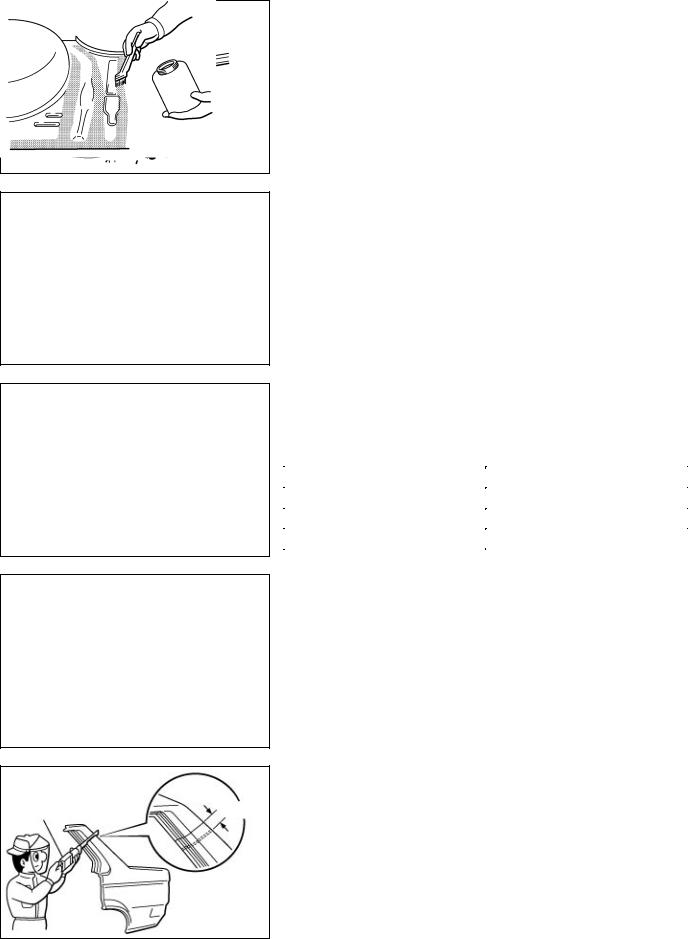
INTRODUCTION |
IN-11 |
Less than 3mm
2.PREPARATION FOR INSTALLATION
(a)SPOT WELD POINTS
(1)When welding panels with a combined thickness of over 3mm (0.12in.), use a MIG (Metal Inert Gas) welder for plug welding.
HINT: Spot welding will not provide sufficient durability for panels over 3mm (0.12in.) thick.
F10011A
(b)APPLICATION OF WELD-THROUGH PRIMER (SPOT SEALER)
(1)Remove the paint from the portion of the new parts and body to be welded, and apply weld-through primer.
F10012
(c)MAKING HOLES FOR PLUG WELDING
(1)For areas where a spot welder cannot be used, use a puncher or drill to make holes for plug welding.
|
|
REFERENCE: |
mm (in.) |
|
|
Thickness of welded portion |
Size of plug hole |
Puncher |
|
1.0 (0.04) under |
5 (0.20) ø over |
|
1.0 (0.04) – 1.5 (0.06) |
6.4 (0.26) ø over |
|
|
F10013A |
1.5 (0.06) over |
8 (0.31) ø over |
|
|
|
(d)SAFETY PRECAUTIONS FOR ELECTRICAL COMPONENTS
(1)When welding, there is a danger that electrical components will be damaged by the electrical current flowing through the body.
(2)Before starting work, disconnect the negative terminal of the battery and ground the welder near the welding location of the body.
F10014
|
20 X 30mm |
Air Saw |
Overlap |
F10015A
(e)ROUGH CUTTING OF JOINTS
(1)For joint areas, rough cut the new parts, leaving 20 – 30mm (0.79 – 1.18in.) overlap.

IN-12 |
INTRODUCTION |
Body |
|
Measurement |
|
Diagrams |
F10016A |
|
|
WRONG |
F10017A |
|
|
CORRECT |
WRONG |
|
F10018A |
|
|
Tip Cutter |
F10019A |
|
|
|
New Spot |
Old |
Locations |
Spot |
|
Locations |
|
|
F10020A |
3.INSTALLATION
(a)PRE-WELDING MEASUREMENTS
(1)Always take measurements before installing underbody or engine components to insure correct assembly. After installation, confirm proper fit.
(b)WELDING PRECAUTIONS
(1)The number of welding spots should be as follows.
Spot weld: 1.3 X No. of manufacturer’s spots. Plug weld: More than No. of manufacturer’s plugs.
(2)Plug welding should be done with a MIG (Metal Inert Gas) welder. Do not gas weld or braze panels at areas other than specified.
(c)POST-WELDING REFINISHING
(1)Always check the welded spots to insure they are secure.
(2)When smoothing out the weld spots with a disc grinder, be careful not to grind off too much as this would weaken the weld.
(d)SPOT WELD LOCATIONS
(1)Try to avoid welding over previous spots.
(e)SPOT WELDING PRECAUTIONS
(1)The shape of the welding tip point has an effect on the strength of the weld.
(2)Always insure that the seams and welding tip are free of paint.
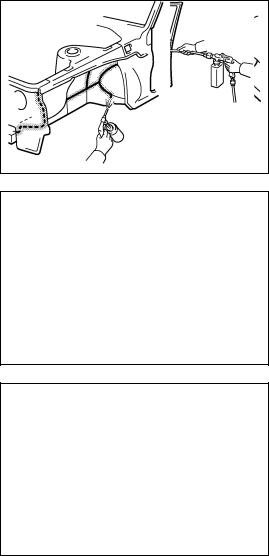
INTRODUCTION |
IN-13 |
Sealer Gun
F10021A
4.ANTI-RUST TREATMENT
(a)BODY SEALER APPLICATION
(1)For water-proofing and anti-corrosion measures, always apply the body sealer to the body panel seams and hems of the doors, hoods, etc.
(b)UNDERCOAT APPLICATION
(1)To prevent corrosion and protect the body from damage by flying stones, always apply sufficient undercoat to the bottom surface of the under body and inside of the wheel housings.
F10022
5.ANTI-RUST TREATMENT AFTER PAINTING PROCESS
(a)ANTI-RUST AGENT (WAX) APPLICATION
(1)To preserve impossible to paint areas from corrosion, always apply sufficient anti-rust agent (wax) to the inside of the hemming areas of the doors and hoods, and around the hinges, or the welded surfaces inside the boxed cross-section structure of the side member, body pillar, etc.
F10023

IN-14 |
INTRODUCTION |
6.ANTI-RUST TREATMENT BY PAINTING
REFERENCE:
Painting prevents corrosion and protect the sheet metal from damage. In this section, anti-chipping paint only for anti-corrosion purpose is described.
(a)ANTI-CHIPPING PAINT
(1)To prevent corrosion and protect the body from damage by flying stones, etc., apply anti-chipping paint to the rocker panel, wheel arch areas, balance panel, etc.
HINT:
Depending on the model or the application area, there are cases where the application of anti-chipping paint is necessary before the second coat or after the top coat.
S Apply the anti-chipping paint after |
S |
Apply the anti-chipping paint before |
the top coat. |
|
the second coat. |
|
Anti-Chipping Paint |
Top Coat |
|
Second Coat |
|
|
Top Coat |
|
|
Anti-Chipping Paint |
|
|
Second Coat |
|
|
|
|
|
Under Coat (ED Primer) |
Under Coat (ED Primer) |
|
Steel Metal |
Steel Metal |
|
|
F10024A |
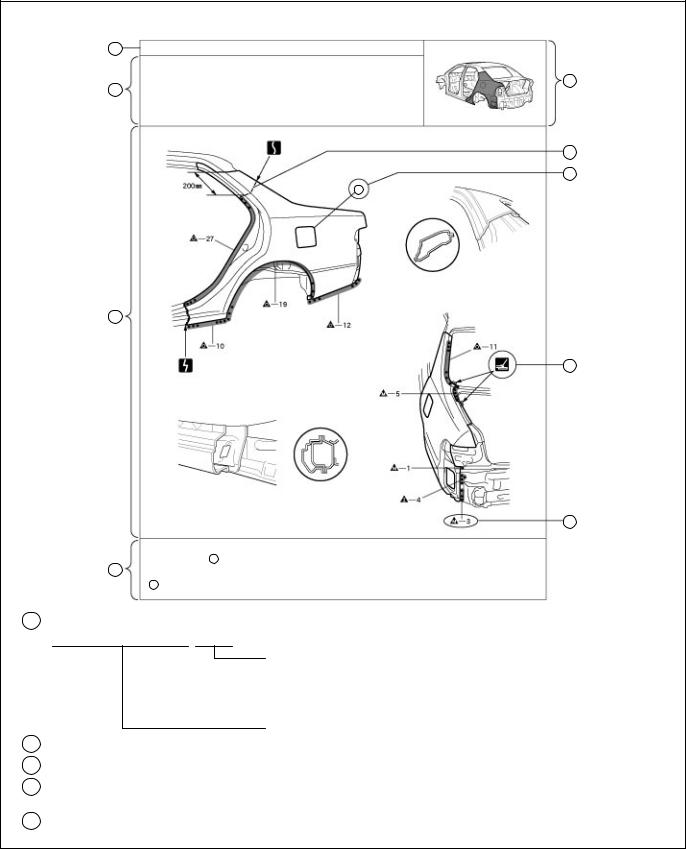
INTRODUCTION |
IN-5 |
HOW TO USE THIS MANUAL
1.BODY PANEL REPLACEMENT THIS MANUAL
BP-34 |
BODY PANEL REPLACEMENT |
A QUARTER PANEL (CUT)
REMOVAL
C
B
I
K
A
D
I
J
POINT
1 Remove the A at the same time.
E |
PART NAME |
A Fuel Filler Opening Lid
A : REPLACEMENT PART AND METHOD
QUARTER PANEL (CUT)
Replacement method
(ASSY) ... Assembly replacement
(CUT) ... Major cutting (less than 1 / 2 of part used) (CUT-H) ... Half cutting (about 1 / 2 of part used) (CUT-P) ... Partial cutting (most of part used)
Replacement part
B: REMOVAL CONDTIONS
C: PART LOCATION
D: REMOVAL DIAGRAM
Describes in detail removal of the damaged part involving repair by cutting.
E : REMOVAL GUIDE
Provides additional information to more efficiently help you perform the removal.
F13890A
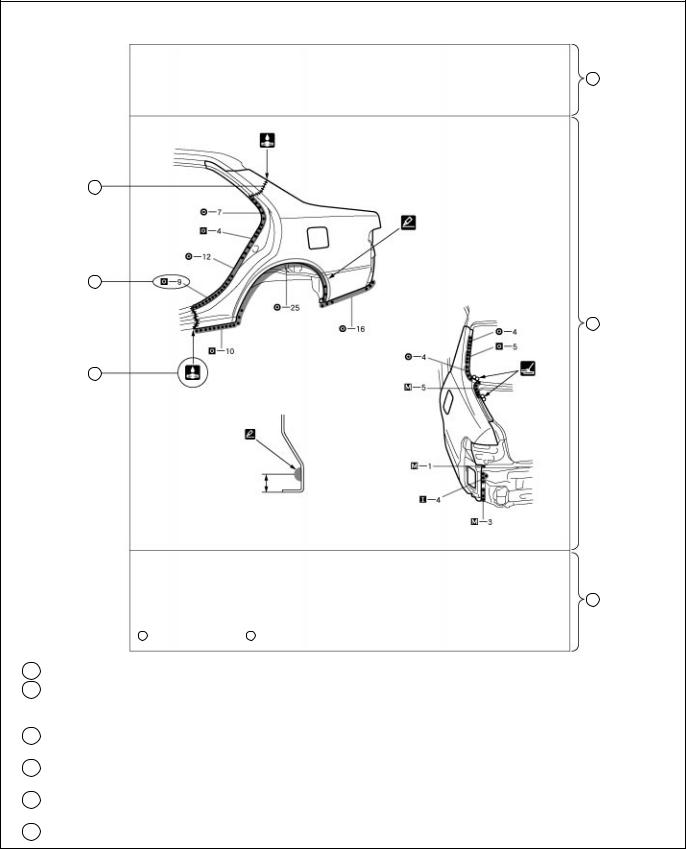
IN-6 |
INTRODUCTION |
BODY PANEL REPLACEMENT |
BP-35 |
INSTALLATION
STemporaily install the new parts and measure each part of the new parts in accordance with the body dimension diagram. (See the body dimension diagram)
SInspect the fiting of the related parts around the new parts before welding. This affects the appearance of the finish.
SAfter welding, apply the polyurethane foam to the corresponding parts.
SAfter welding, apply body sealer and under-coating to the corresponding parts.
SAfter applying the top coat layer, apply anti-rust agent to the inside of the necked section structural weld spots.
I
J
I
F
G
5mm
POINT
1Before temporarily installing the new parts, apply body sealer to the wheel arch.
HINT:
1)Apply body sealer about 5mm (0.20in.) front the flange, avoiding any oozing.
2)Apply sealer evenly, about 3 – 4mm (0.12 – 0.16in.) in diameter.
3)For other sealing points, refer to section PC.
H
PART NAME
A Fuel Filler Opening Lid |
B Waterproof Rivet |
F: INSTALLATION CONDITIONS
G: INSTALLATION DIAGRAM
Describes in detail installation to the new part involving repair by welding and / or cutting, but excluding painting.
H : INSTALLATIOLN GUIDE
Provides additional information to more efficiently help you perform the installation.
I : SYMBOLS
(See page IN-7)
J : ILLUSTRATION OF WELD POINTS
Weld method and panel position symbols (See page IN-9)
K : PART NAME
F13891A
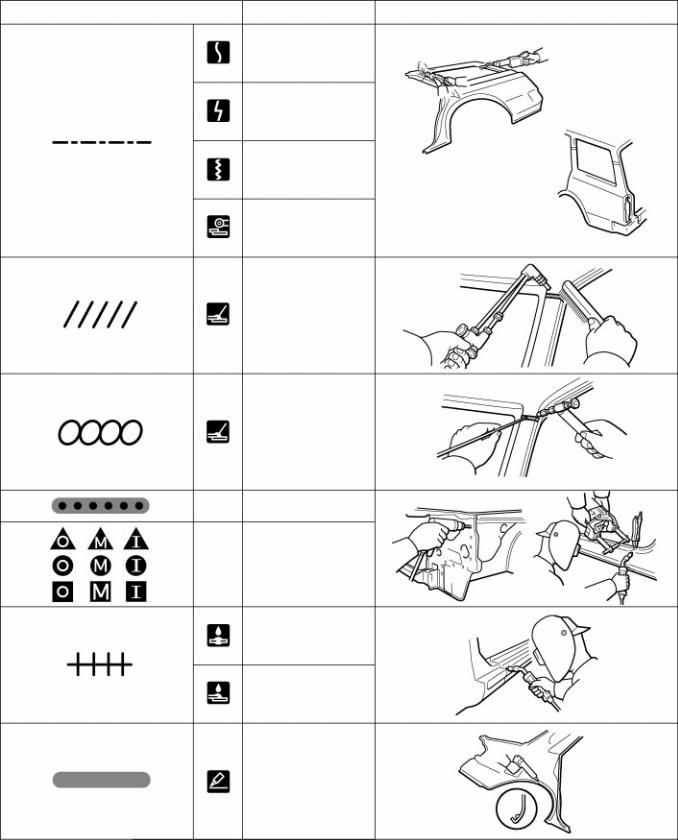
INTRODUCTION |
IN-7 |
2.SYMBOLS
The following symbols are used in the welding diagrams in section BP of this manual to indicate cutting areas and the types of weld required.
SYMBOLS |
MEANING |
ILLUSTRATION |
CUT AND JOIN LOCATION
(SAW CUT)
CUT AND JOIN LOCATION (Cut Location for
Supply Parts)
CUT LOCATION
CUT WITH DISC
SANDER, ETC.
BRAZE (Removal)
BRAZE (Installation)
—WELD POINTS
SPOT WELD OR
—MIG PLUG WELD (See Page IN-9)
CONTINUOUS MIG WELD (BUTT WELD)
CONTINUOUS MIG WELD (TACK WELD)
BODY SEALER
F13893A

IN-8 |
INTRODUCTION |
SYMBOLS |
MEANING |
ILLUSTRATION |
— |
Assembly Mark |
BODY SEALER
—(Flat Finishing)
BODY SEALER
—(No flat Finishing)
F13894A

INTRODUCTION |
IN-9 |
3. ILLUSTRATION OF WELD POINT SYMBOLS EXAMPLE:
REMOVAL |
INSTALLATION |
Weld points
Remove weld point and panel position
SYMBOLS MEANING |
ILLUSTRATION |
Remove
Weld
Points
(Outside)
(Middle)
(Inside)
HINT: Panel position symbols are as seen from the working posture.
Weld points
Weld method and panel position
SYMBOLS MEANING |
ILLUSTRATION |
Spot Weld
MIG Plug
Weld
Spot MIG
Weld
F13892A
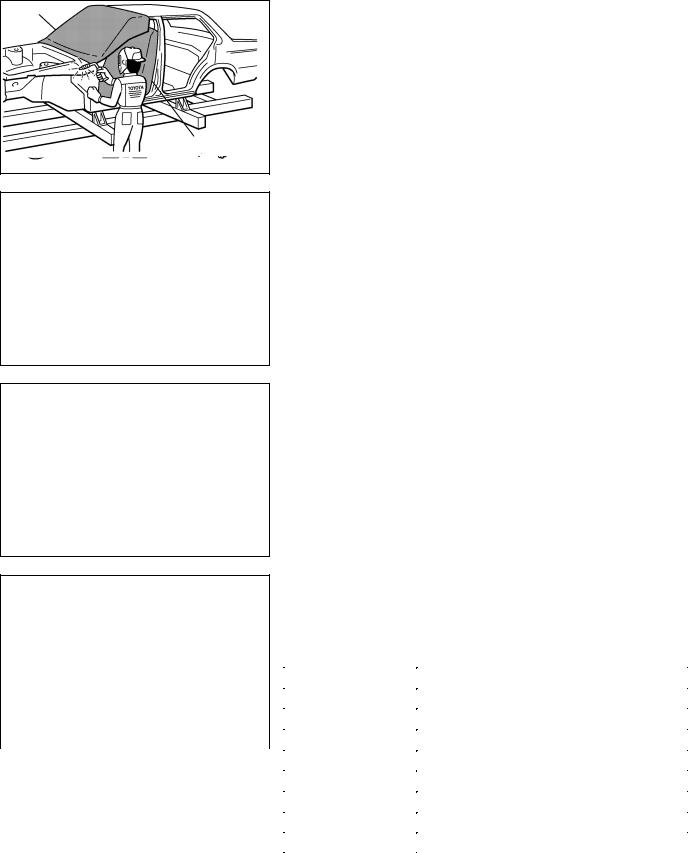
INTRODUCTION |
IN-1 |
Glass Cover
Seat Cover
F10001A
GENERAL REPAIR INSTRUCTIONS
1.WORK PRECAUTIONS
(a)VEHICLE PROTECTION
(1)When welding, protect the painted surfaces, windows, seats and carpet with heat resistant, fire-proof covers.
(b)SAFETY
(1)Never stand in direct line with the chain when using a puller on the body or frame, and be sure to attach a safety cable.
WRONG
F10002A
(2)Before performing repair work, check for fuel leaks. If a leak is found, be sure to close the opening totally.
(3)If it is necessary to use a flame in the area of the fuel tank, first remove the tank and plug the fuel line.
WRONG |
F10003A |
(c)SAFETY WORK CLOTHES
(1)In addition to the usual mechanic’s wear, cap and safety shoes, the appropriate gloves, head protector, glasses, ear plugs, face protector, dust-prevention mask, etc. should be worn as the situation demands.
|
|
Code |
Name |
|
|
A |
Dust-Prevention Mask |
|
|
B |
Face Protector |
F10004 |
|
C |
Eye Protector |
|
|
|
|
|
|
D |
Safety Shoes |
|
|
E |
Welder’s Glasses |
|
|
F |
Ear Plugs |
|
|
G |
Head Protector |
|
|
H |
Welder’s Gloves |
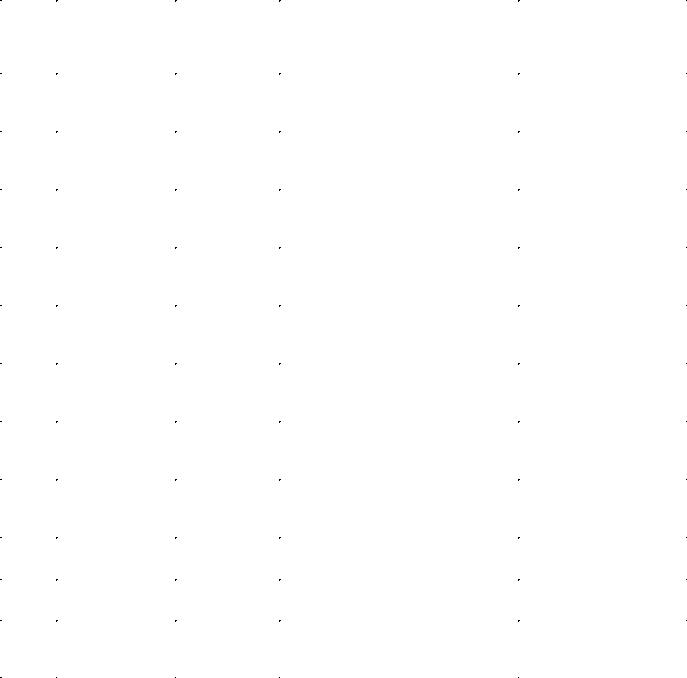
IN-2 |
INTRODUCTION |
2.HANDLING PRECAUTIONS OF PLASTIC BODY PARTS
(1)The repair procedure for plastic body parts must conform with the type of plastic material.
(2)Plastic body parts are identified by the codes in the following table.
(3)When repairing metal body parts adjoining plastic body parts (by brazing, frame cutting, welding, painting etc.), consideration must be given to the property of the plastic.
|
|
Heat* |
|
|
|
Code |
Material |
resistant |
Resistance to |
Notes |
|
name |
temperature |
alcohol or gasoline |
|||
|
|
||||
|
|
limit _C (_F) |
|
|
|
|
Acrylonitrile |
80 |
Alcohol is harmless if applied only for |
Avoid gasoline and organic |
|
AAS |
short time in small amounts (e.g., quick |
||||
Acrylic Styrene |
(176) |
or aromatic solvents. |
|||
|
wiping to remove grease). |
||||
|
|
|
|
||
|
|
|
|
|
|
|
Acrylonitrile |
80 |
Alcohol is harmless if applied only for |
Avoid gasoline and organic |
|
ABS |
short time in small amounts (e.g., quick |
||||
Butadiene Styrene |
(176) |
or aromatic solvents. |
|||
|
wiping to remove grease). |
||||
|
|
|
|
||
|
|
|
|
|
|
|
Acrylonitrile |
80 |
Alcohol is harmless if applied only for |
Avoid gasoline and organic |
|
AES |
short time in small amounts (e.g., quick |
||||
Ethylene Styrene |
(176) |
or aromatic solvents. |
|||
|
wiping to remove grease). |
||||
|
|
|
|
||
|
|
|
|
|
|
|
Acrylonitrile |
80 |
Alcohol is harmless if applied only for |
Avoid gasoline and organic |
|
ASA |
Styrene |
short time in small amounts (e.g., quick |
|||
(176) |
or aromatic solvents. |
||||
|
Acrylate |
wiping to remove grease). |
|||
|
|
|
|||
|
|
|
|
|
|
|
Cellulose |
80 |
Alcohol is harmless if applied only for |
Avoid gasoline and organic |
|
CAB |
short time in small amounts (e.g., quick |
||||
Acetate |
(176) |
or aromatic solvents. |
|||
|
wiping to remove grease). |
||||
|
|
|
|
||
|
|
|
|
|
|
|
Ethylene |
100 |
Alcohol is harmless. |
Most solvents are harmless |
|
EPDM |
Gasoline is harmless if applied only for |
but avoid dipping in gasoline, |
|||
Propylene |
(212) |
||||
|
short time in small amounts. |
solvents, etc. |
|||
|
|
|
|||
|
|
|
|
|
|
|
Fiber |
180 |
|
|
|
FRP |
Reinforced |
Alcohol and gasoline are harmless. |
Avoid alkali. |
||
(356) |
|||||
|
Plastics |
|
|
||
|
|
|
|
||
|
|
|
|
|
|
|
Ethylene |
70 |
Alcohol is harmless if applid only for short |
Avoid gasoline and organic |
|
EVA |
time in small amounts (e.g., quick wiping |
||||
Acetate |
(158) |
or aromatic solvents. |
|||
|
to remove grease). |
||||
|
|
|
|
||
|
|
|
|
|
|
PA |
Polyamide |
80 |
Alcohol and gasoline are harmless. |
Avoid battery acid. |
|
(Nylon) |
(176) |
||||
|
|
|
|||
PBT |
Polybutylene |
160 |
Alcohol and gasoline are harmless. |
Most solvents are harmless. |
|
Terephthalate |
(320) |
||||
|
|
|
|||
|
|
120 |
|
Avoid gasoline brake fluid, |
|
PC |
Polycarbonate |
Alcohol is harmless. |
wax, wax removers and |
||
(248) |
|||||
|
|
|
organic solvents. Avoid alkali. |
||
|
|
|
|
||
|
|
|
|
|
*Temperatures higher than those listed here may result in material deformation during repair.
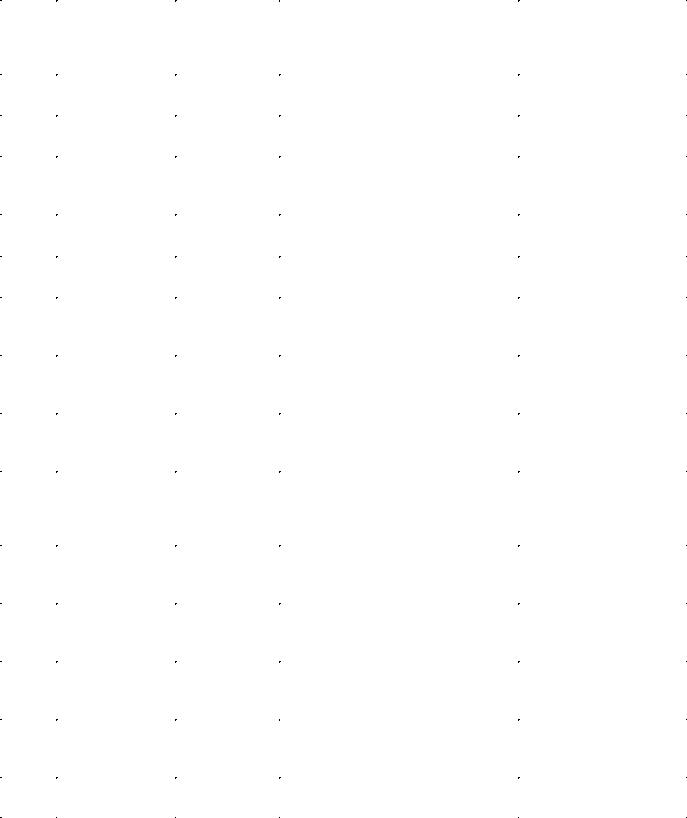
|
|
|
INTRODUCTION |
IN-3 |
|
|
|
|
|
|
|
|
|
Heat* |
|
|
|
Code |
Material |
resistant |
Resistance to |
Notes |
|
name |
temperature |
alcohol or gasoline |
|||
|
|
||||
|
|
limit _C (_F) |
|
|
|
PE |
Polyethylene |
80 |
Alcohol and gasoline are harmless. |
Most solvents are harmless. |
|
(176) |
|||||
|
|
|
|
||
PET |
Polyethylene |
75 |
Alcohol and gasoline are harmless. |
Avoid dipping in water. |
|
Terephthalate |
(167) |
||||
|
|
|
|||
|
Polymethyl |
80 |
Alcohol is harmless if applied only for |
Avoid dipping or immersing |
|
PMMA |
in alcohol, gasoline, |
||||
Methacrylate |
(176) |
short time in small amounts. |
|||
|
solvents, etc. |
||||
|
|
|
|
||
|
|
|
|
|
|
POM |
Polyoxymethylene |
100 |
Alcohol and gasoline are harmless. |
Most solvents are harmless. |
|
(Polyacetal) |
(212) |
||||
|
|
|
|||
PP |
Polypropylene |
80 |
Alcohol and gasoline are harmless. |
Most solvents are harmless. |
|
(176) |
|||||
|
|
|
|
||
|
Modified |
100 |
|
Gasoline is harmless if |
|
PPO |
Polyphenylene |
Alcohol is harmless. |
applied only for quick wiping |
||
(212) |
|||||
|
Oxide |
|
to remove grease. |
||
|
|
|
|||
|
|
|
|
|
|
|
|
60 |
Alcohol and gasoline are harmless if |
Avoid dipping or immersing |
|
PS |
Polystyrene |
applied only for short time in small |
in alcohol, gasoline, |
||
(140) |
|||||
|
|
amounts. |
solvents, etc. |
||
|
|
|
|||
|
|
|
|
|
|
|
|
80 |
Alcohol is harmless if applied only for very |
Avoid dipping or immersing |
|
PUR |
Polyurethane |
short time in small amounts (e.g., quick |
in alcohol, gasoline, |
||
(176) |
|||||
|
|
wiping to remove grease). |
solvents, etc. |
||
|
|
|
|||
|
|
|
|
|
|
|
|
|
Alcohol and gasoline are harmless if |
Avoid dipping or immersing |
|
|
Polyvinylchloride |
80 |
applied only for short time in small |
||
PVC |
in alcohol, gasoline, |
||||
(Vinyl) |
(176) |
amounts (e.g., quick wiping to remove |
|||
|
solvents, etc. |
||||
|
|
|
grease). |
||
|
|
|
|
||
|
|
|
|
|
|
|
Styrene |
80 |
Alcohol is harmless if applied only for |
Avoid dipping or immersing |
|
SAN |
short time in small amounts (e.g., quick |
in alcohol, gasoline, solvents |
|||
Acrylonitrile |
(176) |
||||
|
wiping to remove grease). |
etc. |
|||
|
|
|
|||
|
|
|
|
|
|
|
Thermoplastic |
80 |
Alcohol is harmless. |
Most solvents are harmless |
|
TPO |
Gasoline is harmless if applied only for |
but avoid dipping in gasoline, |
|||
Olefine |
(176) |
||||
|
short time in small amounts. |
solvents, etc. |
|||
|
|
|
|||
|
|
|
|
|
|
|
Thermoplastic |
80 |
Alcohol is harmless if applied only for |
Avoid dipping or immersing |
|
TPU |
short time in small amounts (e.g., quick |
in alcohol, gasoline, |
|||
Polyurethane |
(176) |
||||
|
wiping to remove grease). |
solvents, etc. |
|||
|
|
|
|||
|
|
|
|
|
|
|
TOYOTA |
80 |
|
|
|
TSOP |
Super |
Alcohol and gasoline are harmless. |
Most solvents are harmless. |
||
(176) |
|||||
|
Olefine Polymer |
|
|
||
|
|
|
|
||
|
|
|
|
|
|
UP |
Unsaturated |
110 |
Alcohol and gasoline are harmless. |
Avoid alkali. |
|
Polyester |
(233) |
||||
|
|
|
*Temperatures higher than those listed here may result in material deformation during repair.
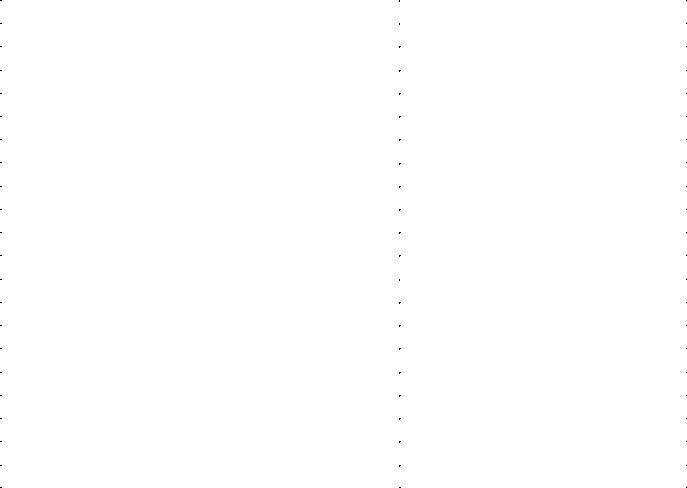
IN-4 |
INTRODUCTION |
3.LOCATION OF PLASTIC BODY PARTS
Parts Name |
Code |
Radiator Grille |
ABS/ASA |
Front Bumper Cover |
TSOP |
Front Spoiler |
TSOP |
Front Bumper Side Moulding |
TSOP |
Headlight Washer Nozzle Cover |
PC/ABS |
Headlight |
PC/PP |
Fog light |
PP |
Side Turn Signal Light |
PMMA/ABS |
Outer Rear View Mirror |
ASA |
Roof Rack Leg Cover (Wagon Only) |
ABS |
Door Outside Handle |
PC/PBT/PA |
Door Outside Moulding |
PP/EPDM |
Body Rocker Panel Moulding |
PP |
Rear Combination Light |
PMMA/PC/ABS |
Rear Spoiler (Wagon Only) |
ABS |
Center Stop Light (Wagon Only) |
PMMA/ABS |
Luggage Compartment Door Outside Garnish |
ABS |
License Plate Light |
PMMA/ABS |
Rear Bumper Cover |
TSOP |
Rear Bumper Side Moulding |
TSOP |
|
D Resin material differs with model. |
|
/ Made up of 2 or more kinds of materials. |
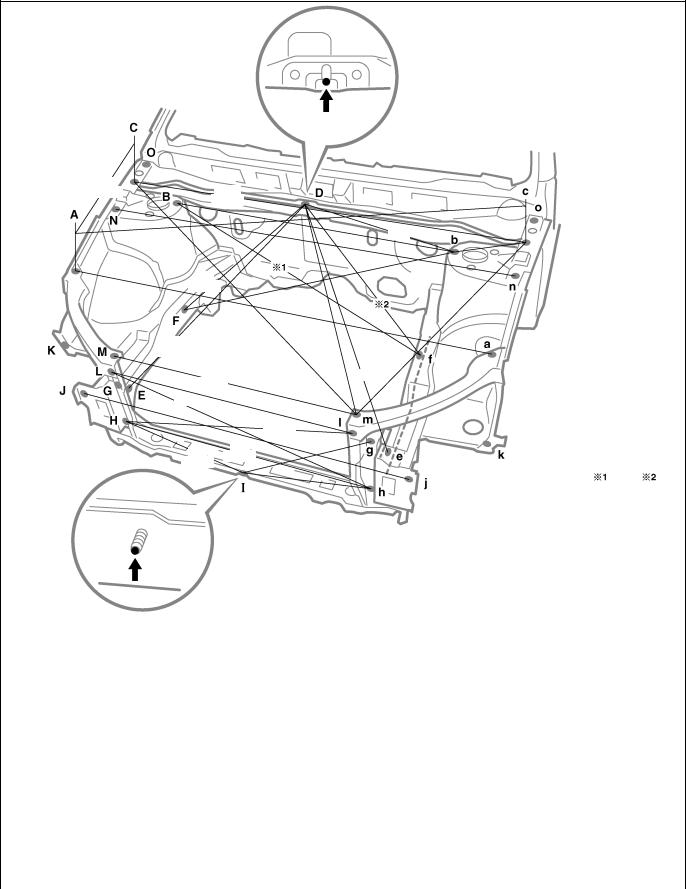
BODY DIMENSIONS |
DI-3 |
BODY DIMENSION DRAWINGS
ENGINE COMPARTMENT
(Three-Dimensional Distance)
467
(18.39) 1,427
(56.18)
647
(25.47)
851
(33.50)
760
(29.92)
854 |
|
|
760 |
|
|
|
(33.62) |
|
|
(29.92) |
|
838
444 (32.99)
(17.48)
|
|
|
|
|
|
|
|
|
|
|
|
|
|
|
|
|
|
|
|
|
|
|
|
|
|
|
|
|
|
|
|
|
1,478 |
|
|
|
|
|
|
|
|
|
|
|
|
|
||
|
|
|
|
|
|
|
|
|
|
|
|
|
|
|
|
|
|
|
|
|
|
|
|
|
|
|
|
|
|
|
|
|
(58.19) |
|
|
|
|
|
|
|
|
|
|
|
|
|
||
|
|
|
|
|
|
|
|
|
|
|
|
|
|
|
|
|
|
|
|
|
|
|
|
523 |
|
|
|
|
|
|
|
|
|
|
|
|
|
|
|
|
|
|
|
|||||
|
|
|
|
|
|
|
|
|
|
|
|
|
|
|
|
1,023 |
|
|
|
|
|
|
|
|
|
|
|
|
|
|
|
|
|
|
|
|
|
|
|
|
||||||||
|
|
|
|
1,410 |
|
|
|
|
|
|
|
|
|
|
|
(20.59) |
|
|
|
|
|
|
|
|
|
|
|
|
|
|
|
|
|
|
||||||||||||||
|
|
|
|
|
|
|
|
|
|
|
(40.28) |
|
|
|
|
|
|
|
|
|
|
|
|
|
|
|
|
|
|
|
|
|
||||||||||||||||
|
|
|
|
|
|
|
|
|
|
|
|
|
|
|
|
|
|
|
|
|
|
|
|
|
|
|
|
|
|
|
|
|
|
|
|
|||||||||||||
|
|
|
|
|
|
|
|
|
|
|
|
|
|
|
|
|
|
|
|
|
|
|
|
|
|
210 |
|
|
|
|
|
|
||||||||||||||||
|
|
|
(55.51) |
|
|
|
|
|
|
|
|
|
|
|
|
|
|
|
|
|
|
|
|
|
|
|
|
|
|
|
|
|
|
|
|
|
|
|
|
|||||||||
|
|
|
|
|
|
|
|
|
|
|
|
|
|
|
|
|
|
|
|
|
|
|
|
|
|
|
|
|
|
|||||||||||||||||||
|
|
|
|
|
|
|
|
|
|
|
|
|
|
|
|
|
|
|
|
|
|
|
|
|
|
|
|
|
|
|
|
|
(6.27) |
|
|
|
|
|
||||||||||
|
|
|
|
|
|
|
|
|
|
|
|
|
|
|
|
|
|
|
|
|
|
|
|
|
|
|
|
|
|
|
|
|
|
|
|
|
|
|||||||||||
|
|
|
|
|
|
|
|
|
|
|
|
|
|
|
|
|
|
|
1,038 |
|
|
|
|
|
|
|
|
|
|
|
|
|
|
|
|
|
|
|
|
|
||||||||
|
|
|
|
|
|
|
|
|
|
|
|
|
|
|
|
|
|
|
|
|
|
|
|
|
|
|
|
|
|
|
|
|
|
|
|
|
|
|
|
|
|
|
|
|||||
|
|
|
|
|
|
|
|
|
|
|
|
|
|
|
|
|
|
|
|
|
|
|
(40.87) |
|
|
|
|
|
|
|
|
|
|
|
|
|
|
|
|
|
|
|
|
|
||||
|
|
|
|
|
|
|
|
|
|
|
|
|
|
|
|
|
|
|
|
|
|
|
|
|
|
|
|
|
|
|
|
|
|
|
|
|
|
|
|
|
|
|
|
|
|
|
||
|
|
|
|
|
|
|
|
|
|
|
|
|
|
|
|
|
|
|
|
|
|
|
|
|
|
|
|
|
|
|
|
817 |
|
|
|
|
|
|
|
|
|
|
||||||
|
|
|
1,378 |
|
|
|
|
|
|
|
|
|
|
|
|
|
|
|
|
|
|
|
|
|
|
|
|
(32.17) |
|
|
|
|
|
|
|
|
|
|||||||||||
|
|
|
(54.25) |
|
|
|
|
|
|
|
|
|
|
|
|
|
|
|
|
|
|
|
|
|
|
|
|
|
|
|
|
|
|
|
|
|
|
|
|
|
|
|||||||
|
|
|
|
|
|
|
|
|
|
|
|
|
|
|
|
|
|
|
|
|
|
|
|
|
|
|
|
|
|
|
|
|
|
|
|
|
|
|
|
|
|
|||||||
|
|
|
|
|
|
|
|
|
|
|
|
|
|
|
|
|
|
|
|
|
|
|
|
|
|
|
|
|
|
|
|
|
|
|
|
|
|
|
|
|
|
|
|
|||||
|
1,323 |
|
|
|
|
|
|
|
|
|
|
|
|
|
|
|
|
|
|
|
|
|
|
|
|
|
|
|
|
|
|
|
|
|
|
|
|
|
|
|
||||||||
768 |
|
|
|
|
|
|
|
|
|
|
|
|
|
|
|
|
|
|
|
|
|
|
|
|
|
|
|
|
|
|
|
|||||||||||||||||
|
|
|
(52.09) |
|
|
|
|
|
|
|
|
|
|
|
|
|
|
|
|
|
|
|
|
|
|
|
|
|
|
|
|
|
|
|
|
|
|
|
|
|
||||||||
|
|
|
|
|
(30.24) |
|
|
|
|
|
|
|
|
|
|
|
|
|
|
|
|
|
|
|
|
|
|
|
|
|
|
|
|
|
|
|
||||||||||||
|
|
|
|
|
|
|
|
|
|
|
|
|
|
|
|
|
|
|
834 |
|
|
|
|
|
|
|
|
|
|
|
|
|
|
|
|
|
|
|
|
|
|
|
|
|
||||
|
|
|
|
|
|
|
|
|
|
|
|
|
|
|
|
|
|
|
|
|
|
|
|
|
|
|
|
|
|
|
|
|
|
|
|
|
|
|
|
|
|
|
|
|
||||
|
|
|
|
|
|
|
|
|
|
|
|
|
|
|
|
|
|
|
|
(32.83) |
|
|
|
|
|
|
|
|
|
|
|
|
|
|
|
|
|
|
|
|
|
|
|
|
||||
874 |
|
|
|
|
|
|
|
|
|
|
|
|
|
|
|
|
|
|
|
|
|
|
|
|
|
|
|
|
|
|
|
|
|
|
|
|
|
|
|
|
|
|
|
|||||
(34.41) |
|
|
|
|
|
|
|
537 |
|
|
|
|
|
|
|
|
|
|
|
|
|
|
|
|
|
|
|
|
|
|
|
|
|
|
|
|
|
|
|
|||||||||
|
|
|
|
|
|
|
|
|
|
|
|
|
|
|
|
|
|
|
|
|
|
|
|
|
|
|
|
|
|
|
|
|
|
|
|
|
|
|
|
|
|
|
|
|||||
|
|
|
|
|
|
|
|
|
|
|
|
|
(21.14) |
|
|
|
|
|
|
|
|
|
|
|
|
|
|
|
|
|
|
|
|
|
|
|
|
|
|
|
|
|
|
|||||
|
|
|
|
|
|
|
|
|
|
|
|
|
|
|
|
|
|
|
|
|
|
|
|
|
|
|
|
|
|
|
|
|
|
|
|
|
|
|
|
|
|
|||||||
|
|
|
|
|
|
|
|
|
|
|
|
|
|
|
|
1,089 |
|
|
|
|
|
|
|
|
|
|
|
|
|
|
|
|
|
|
|
|
|
|
|
|
||||||||
|
422 |
|
|
|
|
|
|
|
|
|
|
|
|
(42.87) |
|
|
|
|
|
|
|
|
|
|
|
|
|
|
|
|
|
|
|
|
Engine |
|
|
|
||||||||||
|
(16.61) |
|
|
|
|
|
|
|
|
|
|
|
|
|
|
|
|
|
|
|
|
|
|
|
|
|
|
|
|
|
|
|
|
|
|
|
|
|
|
Model |
|
|
|
|||||
|
|
|
|
|
|
|
|
|
|
|
|
|
|
|
|
|
|
|
|
|
|
|
|
|
|
|
|
|
|
|
|
|
|
|
|
|
|
|
|
|||||||||
|
|
|
|
|
|
|
|
|
|
|
|
|
|
|
|
|
|
|
|
|
|
|
|
|
|
|
|
|
|
|
|
|
|
|
|
|
|
|
|
|
|
|
|
|
|
|
|
|
|
|
|
|
|
|
|
|
|
|
|
|
|
|
|
|
|
|
|
|
|
|
|
|
|
|
|
|
|
|
|
|
|
|
|
|
|
|
|
|
|
|
|
|
|
AZ |
1,022 |
625 |
|
|
|
|
|
|
|
|
|
|
|
|
|
|
|
|
|
|
|
|
|
|
|
|
|
|
|
|
|
|
|
|
|
|
|
|
|
|
|
|
|
|
|
|
|
|
(40.24) |
(24.61) |
|
|
|
|
|
|
|
|
|
|
|
|
|
|
|
|
|
|
|
|
|
|
|
|
|
|
|
|
|
|
|
|
|
|
|
|
|
|
|
|
|
|
|
|
|
|
|
|
|
||
|
|
|
|
|
|
|
|
|
|
|
|
|
|
|
|
|
|
|
|
|
|
|
|
|
|
|
|
|
|
|
|
|
|
|
|
|
|
|
|
|
|
|
|
|
ZZ, CD |
1,010 |
606 |
|
|
|
|
|
|
|
|
Vehicle Dimensions |
|
|
|
|
|
|
|
|
|
|
|
|
|
(39.76) |
(23.86) |
|
|||||||||||||||||||||||||
|
|
|
|
|
|
|
|
|
|
|
|
|
|
|
|
|
|
|
|
|
|
|||||||||||||||||||||||||||
|
|
|
|
|
|
|
|
|
|
|
|
|
|
|
|
|
|
|
|
|
|
|
|
|
|
|
|
|
|
|
|
|
|
|
|
|
|
|
|
|
|
|
|
|
|
|
|
|
|
|
|
|
|
|
|
|
B-c |
|
|
|
|
|
|
C-n |
|
|
|
|
C-N |
|
C-O |
|
|
|
|
|
G-g |
G-h |
g-H |
|
|
||||||||||||||||
|
|
|
|
|
|
|
|
or |
|
|
|
|
|
|
|
or |
|
|
|
|
or |
|
|
or |
|
|
|
|
|
|
|
|||||||||||||||||
|
|
|
|
|
|
|
|
b-C |
|
|
|
c-N |
|
|
|
|
c-n |
|
c-o |
|
|
|
|
|
|
|
|
|
|
|||||||||||||||||||
|
|
|
|
|
|
|
1,227 |
|
|
1,428 |
159 |
113 |
|
|
|
|
828 |
854 |
876 |
|
|
|||||||||||||||||||||||||||
|
|
|
|
|
|
|
(48.31) |
|
(56.22) |
(6.26) |
(4.45) |
|
|
(32.60) |
(33.62) |
(34.49) |
|
|
||||||||||||||||||||||||||||||
|
|
|
|
|
|
|
|
|
|
|
|
|
|
|
|
|
|
|
|
|
|
|
|
|
|
|
|
|
|
|
|
|
|
|
|
|
|
|
|
|
|
|
|
|
|
|
|
|
|
|
|
|
|
|
|
|
I-j |
|
|
|
|
|
|
|
I-J |
|
|
|
|
J-L |
|
|
j-l |
|
|
|
|
|
K-k |
N-o |
N-O |
|
|
||||||||||||||
|
|
|
|
|
|
|
|
|
|
|
|
|
|
|
|
|
|
|
|
|
|
|
|
|
|
or |
or |
|
|
|||||||||||||||||||
|
|
|
|
|
|
|
|
|
|
|
|
|
|
|
|
|
|
|
|
|
|
|
|
|
|
|
|
|
|
|
|
|
|
|
|
|
|
|
|
|
|
|
|
|
n-O |
n-o |
|
|
|
|
|
|
|
|
|
593 |
|
|
607 |
250 |
240 |
|
|
|
|
1,439 |
1,452 |
272 |
|
|
|||||||||||||||||||||||||||
|
|
|
|
|
|
|
(23.35) |
|
(23.90) |
(9.84) |
(9.45) |
|
|
(56.65) |
(57.17) |
(10.71) |
mm (in.) |
|||||||||||||||||||||||||||||||
Symbol |
Name |
Hole dia. |
|
Symbol |
Name |
Hole dia. |
||
A, |
a |
Front fender installation nut |
6 (0.24) nut |
|
I |
|
Hood lock brace installation bolt |
6 (0.24) bolt |
B, |
b |
Front spring support hole-inner |
11 (0.43) |
|
J, |
j |
Front side member rear plate standard hole |
13 (0.51) |
C, |
c |
Front fender installation nut |
6 (0.24) nut |
|
K, |
k |
Front fender extention standard hole |
7 (0.28) |
D |
|
Cowl top inner panel standard hole |
— |
|
L, |
l |
Radiator upper support installation nut |
6 (0.24) nut |
E, |
e |
Front side member standard hole |
18 (0.71) |
|
M, |
m |
Radiator upper support installation nut |
6 (0.24) nut |
F, |
|
Front side member standard hole |
12 (0.47) |
|
N, |
n |
Front apron to cowl side upper member |
10 (0.39) |
|
f |
Engine mounting installation nut |
10 (0.39) nut |
|
standard hole |
|||
|
|
|
|
|
||||
G, |
g |
Radiator support standard hole |
10 (0.39) |
|
O, |
o |
Hood hinge installation nut |
8 (0.31) nut |
H, |
h |
Front crossmember side gusset standard hole |
10 (0.39) |
|
— |
|
— |
— |
